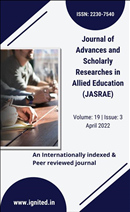Physical-chemical analysis of Wetlands with variety in Zooplankton and Phytoplankton
Exploring the Relationship Between Physical-Chemical Characteristics and Zooplankton/Phytoplankton Populations in Wetlands
Keywords:
wetlands, zooplankton, phytoplankton, physical-chemical analysis, variety, richness, influenced, physical properties, chemical properties, water samples, size, depth, water flow patterns, chemical factors, pH, dissolved oxygen levels, nutrient concentrations, organic matter content, distribution, species, correlated, findings, diverse, interact, ecological health, functioning, environmental changes, ecosystem, stability, resilienceAbstract
The variety and richness of zooplankton and phytoplankton populations within these habitatsare significantly influenced by the physical and chemical properties of wetlands. This research sought todetermine how the physical-chemical characteristics of wetlands and the variation in zooplankton andphytoplankton populations related to one another. The study entailed collecting and analysing watersamples from several wetlands with a variety of physical characteristics, including size, depth, and waterflow patterns. Measurements were made of a number of chemical factors, such as pH, dissolved oxygenlevels, nutrient concentrations, and organic matter content. Samples of phytoplankton and zooplanktonwere also taken at the same time and identified to determine their relative quantity and composition. Thedistribution of zooplankton and phytoplankton species and the physical-chemical characteristics ofwetlands were shown to be significantly correlated in the findings. In conclusion, our research showedhow diverse zooplankton and phytoplankton populations interact intricately with physical-chemicalfactors in wetland ecosystems. Understanding these connections may help with efforts to conserve andmanage wetlands in the face of environmental changes by revealing important information about theirecological health and functioning. The dynamics of these interactions throughout time and how theyaffect the stability and resilience of an ecosystem as a whole might be the subject of future study.Published
2022-04-01
How to Cite
[1]
“Physical-chemical analysis of Wetlands with variety in Zooplankton and Phytoplankton: Exploring the Relationship Between Physical-Chemical Characteristics and Zooplankton/Phytoplankton Populations in Wetlands”, JASRAE, vol. 19, no. 3, pp. 464–470, Apr. 2022, Accessed: Jul. 03, 2024. [Online]. Available: https://ignited.in/jasrae/article/view/13904
Issue
Section
Articles
How to Cite
[1]
“Physical-chemical analysis of Wetlands with variety in Zooplankton and Phytoplankton: Exploring the Relationship Between Physical-Chemical Characteristics and Zooplankton/Phytoplankton Populations in Wetlands”, JASRAE, vol. 19, no. 3, pp. 464–470, Apr. 2022, Accessed: Jul. 03, 2024. [Online]. Available: https://ignited.in/jasrae/article/view/13904








